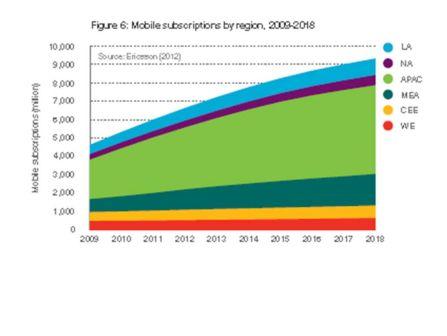Smartphones are only one driver of global bandwidth demand, and only one of several demand drivers for mobile networks in particular. And though the number of smartphones in use is far larger than the number of PCs, tablets and routers tethered or directly connected to mobile networks, a typical router, connected tablet or PC represents about an order of magnitude more consumption, compared to a smartphone.
Between 2012 and 2018, for example, use of mobile PCs, tablets and routers will roughly match the amount of data consumed by smartphones, as the number of smartphones in use grows dramatically.
Total smartphone subscriptions will reach 1.1 billion by the end of 2012, and are expected to grow to 3.3 billion in 2018. Today, though, the majority of mobile subscriptions are for basic phones.
Even though smartphone penetration will increase significantly, subscriptions for basic phones and inactive subscriptions are expected to stay at around five billion into the foreseeable future.
In 2018, almost all handsets in Western Europe and North America will be smartphones, compared to only around one-third of handsets for Middle East and Africa, and the Asia Pacific.
Still, it is tethering and direct connection of PCs, routers and tablets that will have an outsized impact.
On average, a mobile PC generates approximately seven times more traffic than a smartphone. By the end of 2012, an average mobile PC generated approximately 3 GBytes per month, compared to 450 MBytes per month consumed by the average smartphone.
Traffic per subscriber is also partly affected by the screen size of the user’s individual device. Resolution is a factor as well, with recent smartphones closing in on PC-level quality.
By the end of 2018, it is estimated that a mobile PC will generate over 10 GBytes per month, and a smartphone around 2 GBytes.
By the end of 2012, total mobile subscriptions will be around 6.6 billion. By the end of 2018, they’re expected to reach 9.3 billion. These figures do not include machine-to-machine subscriptions.

Global mobile broadband subscriptions will be around 1.5 billion in 2012, and are predicted to reach 6.5 billion in 2018.
Ericsson expects the subscription types associated with large data volumes (such as those for mobile PCs and smartphones) to exceed four billion by 2018.
Mobile subscriptions are increasing for PCs, mobile routers and tablets that use large screen sizes. They are expected to grow from 250 million in 2012 to around 850 million in 2018, exceeding the number of fixed broadband subscriptions.
Those device trends matter. In 2012, overall mobile data traffic is expected to continue the trend of doubling each year. Today, mobile PCs dominate traffic in most regions, except in North America.
But smartphone traffic is growing faster due to the high growth in number of subscriptions. In the latter years of the forecast period, data traffic will be split fairly equally between mobile phones on one hand and mobile PCs, tablets and mobile routers on the other.
Mobile data traffic will grow considerably faster than fixed data traffic over the forecast period. However, in absolute volume, fixed data traffic will remain dominant over the same period.
Mobile data traffic is expected to grow with a CAGR of around 50 percent (2012-2018), driven mainly by video. This entails growth of around 12 times by the end of 2018.
On an average mobile network, around 3.5 percent of Android smartphones are used to tether other devices and enable internet access, according to Ericsson. The tethering penetration is in the network with the highest amount of Android tethering users.
The average traffic per subscription from tethering users can be up to 20 times higher than for those that do not tether, in large part because the devices consuming the most data, and which are most often tethered, are PCs.
Edited by
Braden Becker